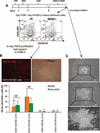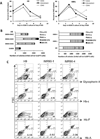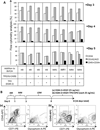Efficient and simultaneous generation of hematopoietic and vascular progenitors from human induced pluripotent stem cells
- PMID: 22736485
- PMCID: PMC3535514
- DOI: 10.1002/cyto.a.22090
Efficient and simultaneous generation of hematopoietic and vascular progenitors from human induced pluripotent stem cells
Abstract
The hematopoietic and vascular lineages are intimately entwined as they arise together from bipotent hemangioblasts and hemogenic endothelial precursors during human embryonic development. In vitro differentiation of human pluripotent stem cells toward these lineages provides opportunities for elucidating the mechanisms of hematopoietic genesis. We previously demonstrated the stepwise in vitro differentiation of human embryonic stem cells (hESC) to definitive erythromyelopoiesis through clonogenic bipotent primitive hemangioblasts. This system recapitulates an orderly hematopoiesis similar to human yolk sac development via the generation of mesodermal-hematoendothelial progenitor cells that give rise to endothelium followed by embryonic primitive and definitive hematopoietic cells. Here, we report that under modified feeder-free endothelial culture conditions, multipotent CD34⁺ CD45⁺ hematopoietic progenitors arise in mass quantities from differentiated hESC and human induced pluripotent stem cells (hiPSC). These hematopoietic progenitors arose directly from adherent endothelial/stromal cell layers in a manner resembling in vivo hematopoiesis from embryonic hemogenic endothelium. Although fibroblast-derived hiPSC lines were previously found inefficient in hemato-endothelial differentiation capacity, our culture system also supported robust hiPSC hemato-vascular differentiation at levels comparable to hESC. We present comparative differentiation results for simultaneously generating hematopoietic and vascular progenitors from both hESC and fibroblast-hiPSC. This defined, optimized, and low-density differentiation system will be ideal for direct single-cell time course studies of the earliest hematopoietic events using time-lapse videography, or bulk kinetics using flow cytometry analyses on emerging hematopoietic progenitors.
Copyright © 2012 International Society for Advancement of Cytometry.
Figures





Similar articles
-
A novel serum-free monolayer culture for orderly hematopoietic differentiation of human pluripotent cells via mesodermal progenitors.PLoS One. 2011;6(7):e22261. doi: 10.1371/journal.pone.0022261. Epub 2011 Jul 27. PLoS One. 2011. PMID: 21818303 Free PMC article.
-
Hematopoietic differentiation of human embryonic stem cells progresses through sequential hematoendothelial, primitive, and definitive stages resembling human yolk sac development.Blood. 2005 Aug 1;106(3):860-70. doi: 10.1182/blood-2004-11-4522. Epub 2005 Apr 14. Blood. 2005. PMID: 15831705 Free PMC article.
-
Cytokine-free directed differentiation of human pluripotent stem cells efficiently produces hemogenic endothelium with lymphoid potential.Stem Cell Res Ther. 2017 Mar 17;8(1):67. doi: 10.1186/s13287-017-0519-0. Stem Cell Res Ther. 2017. PMID: 28302184 Free PMC article.
-
Challenges and strategies for generating therapeutic patient-specific hemangioblasts and hematopoietic stem cells from human pluripotent stem cells.Int J Dev Biol. 2010;54(6-7):965-90. doi: 10.1387/ijdb.093043ap. Int J Dev Biol. 2010. PMID: 20563986 Free PMC article. Review.
-
Regulation of Hemogenic Endothelial Cell Development and Function.Annu Rev Physiol. 2021 Feb 10;83:17-37. doi: 10.1146/annurev-physiol-021119-034352. Epub 2020 Oct 9. Annu Rev Physiol. 2021. PMID: 33035429 Free PMC article. Review.
Cited by
-
Stem cell therapies in the treatment of diabetic retinopathy and keratopathy.Exp Biol Med (Maywood). 2016 Mar;241(6):559-68. doi: 10.1177/1535370215609692. Epub 2015 Oct 9. Exp Biol Med (Maywood). 2016. PMID: 26454200 Free PMC article. Review.
-
iPS cell modeling of cardiometabolic diseases.J Cardiovasc Transl Res. 2013 Feb;6(1):46-53. doi: 10.1007/s12265-012-9413-4. Epub 2012 Oct 16. J Cardiovasc Transl Res. 2013. PMID: 23070616 Free PMC article. Review.
-
Enrichment of Scleroderma Vascular Disease-Associated Autoantigens in Endothelial Lineage Cells.Arthritis Rheumatol. 2016 Oct;68(10):2540-9. doi: 10.1002/art.39743. Arthritis Rheumatol. 2016. PMID: 27159521 Free PMC article.
-
A human bone marrow mesodermal-derived cell population with hemogenic potential.Leukemia. 2018 Jul;32(7):1575-1586. doi: 10.1038/s41375-018-0016-1. Epub 2018 Feb 2. Leukemia. 2018. PMID: 29467489 Free PMC article.
-
Skimmianine attenuates liver ischemia/reperfusion injury by regulating PI3K-AKT signaling pathway-mediated inflammation, apoptosis and oxidative stress.Sci Rep. 2023 Oct 25;13(1):18232. doi: 10.1038/s41598-023-45354-2. Sci Rep. 2023. PMID: 37880319 Free PMC article.
References
-
- Takahashi K, Tanabe K, Ohnuki M, Narita M, Ichisaka T, Tomoda K, Yamanaka S. Induction of pluripotent stem cells from adult human fibroblasts by defined factors. Cell. 2007;131:861–872. - PubMed
-
- Yu J, Vodyanik MA, Smuga-Otto K, Antosiewicz-Bourget J, Frane JL, Tian S, Nie J, Jonsdottir GA, Ruotti V, Stewart R, et al. Induced pluripotent stem cell lines derived from human somatic cells. Science. 2007;318:1917–1920. - PubMed
-
- Lengerke C, Daley GQ. Disease models from pluripotent stem cells. Annals of the New York Academy of Sciences. 2009;1176:191–196. - PubMed
-
- Grskovic M, Javaherian A, Strulovici B, Daley GQ. Induced pluripotent stem cells—Opportunities for disease modelling and drug discovery. Nature reviews. Drug Discov. 2011;10:915–929. - PubMed
Publication types
MeSH terms
Substances
Grants and funding
LinkOut - more resources
Full Text Sources
Other Literature Sources
Medical
Research Materials
Miscellaneous

